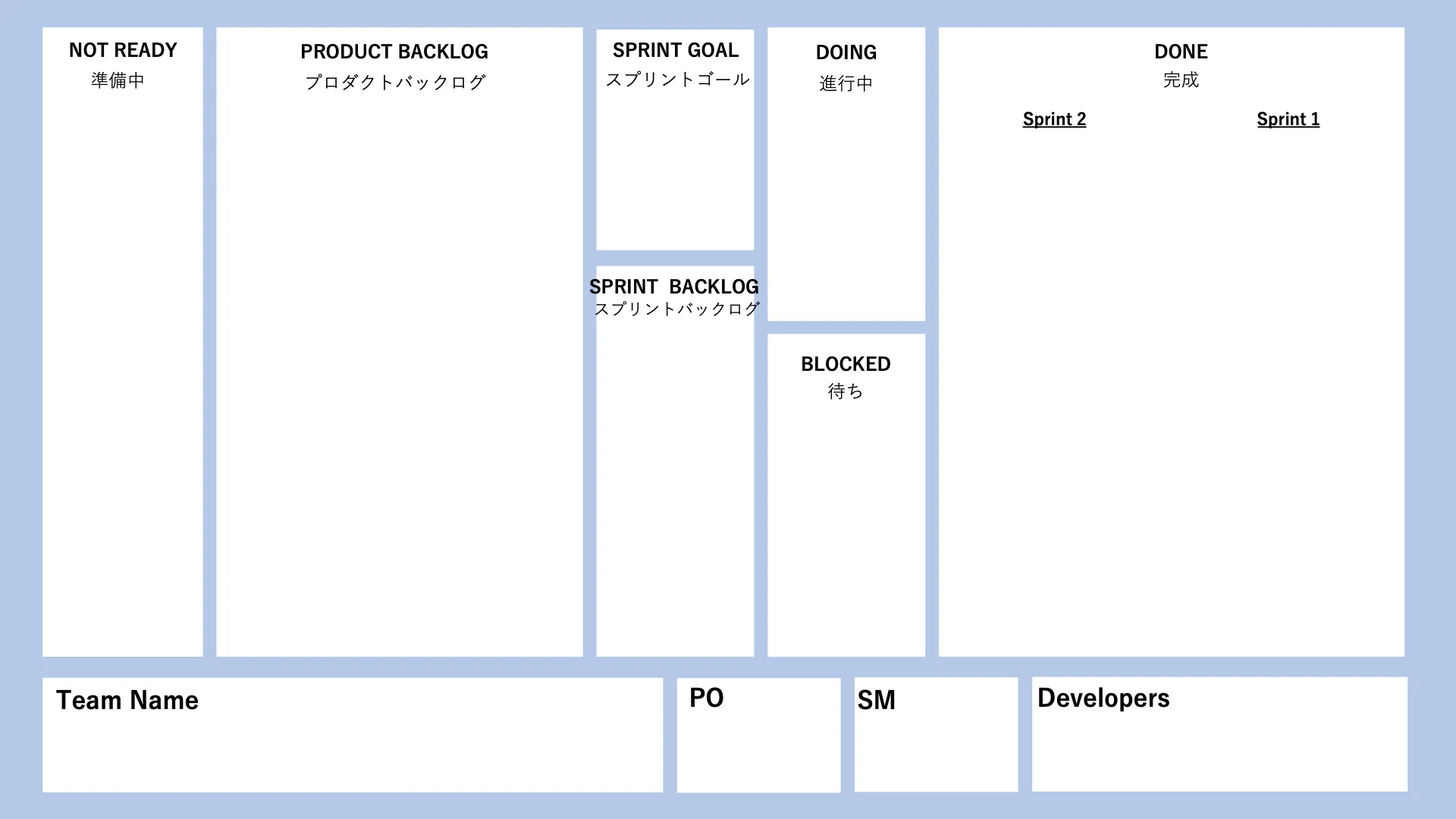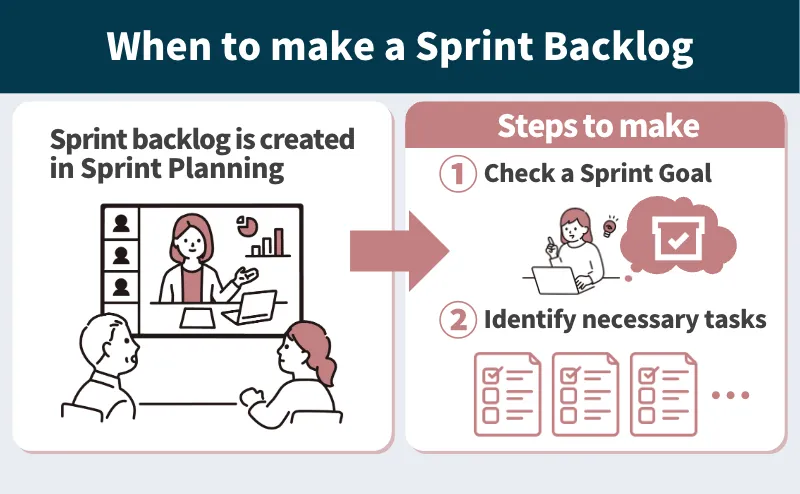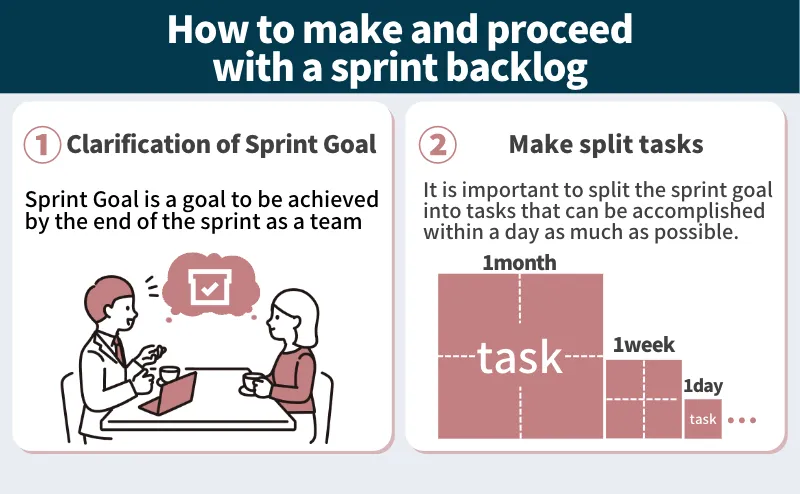What is Sprint Backlog in Agile Development
The Sprint Backlog is one of the three artifacts in Scrum, along with the Product Backlog and the Increment.
The Sprint Backlog is like a task list of features and services that the team aims to complete during the sprint .
In this article, we’ll take a closer look at what a Sprint Backlog is, its purpose, benefits, and how to create one.
What is the Sprint Backlog in Agile?


A Sprint Backlog is like a list of tasks to complete one Product Backlog item (a list of features or services).
Plan and decide each sprint.
The goal for each sprint is called the “Sprint Goal” , and it is common to create a Sprint Backlog accordingly .
Also, the duration of one sprint varies depending on the organization, but for a team that is used to it, it is about one to two weeks .
A sprint is not just a period of time, but a period of time that includes testing and release.
In other words , the period during which the product can be released is the sprint period .
By repeating improvements, the sprint duration will gradually shorten.
Overall Agile Board Image
Below is an image of the entire backlog. The backlog includes the following items


A place to place ideas in the pre-product backlog stage and work items to be considered in the future.
This is a list of each sprint-sized project, product, or service. Each item is prioritized.
A goal to be achieved in one sprint. The product backlog items (user stories) that should normally be accomplished in that sprint. When tasked in a Sprint Backlog, you can lose sight of your development objectives. The sprint goal helps the team to have a common understanding of what the task is for and what value it brings.
A task list (work list) for completing the highest priority product backlog items within the duration of the sprint.
Where the team places items for the Sprint Backlog that is currently in progress.
A place to put work waiting for external dependencies, such as another team or vendor, or a robotic process outside the control of your team.
Where to place completed items for each sprint. Meets the definition of done and shows what was completed in each past sprint.
Purpose of the Sprint Backlog
The purpose is to set in more detail than the product backlog , such as how to implement it, including technical matters .
Information sharing is important in the sprint backlog, and the advantage of creating a sprint backlog is that everyone in the team can work on their work after understanding the goals .
Increased productivity due to better collaboration as a team.
Usage scene
Since the work in the sprint backlog is detailed and small, it is possible to detect defects early, repair them, and review them.
In other words, it can be said that it helps to shorten the development period and reduce the development cost .
Elements in the Sprint Backlog


Here are the elements that are typically included in the Sprint Backlog:
User story
A description of the feature or service being developed, written from the perspective of each persona. The purpose is to clarify how the development items provide value to each persona.
User stories are useful for quickly understanding the “who”, “what” and “why” of a requirement .
We break this user story down into a detailed list of tasks in the Sprint Backlog.
Task and description
Tasks for that sprint. Tasks or descriptions necessary to achieve the sprint goal,
such as ‘build login screen’ or ‘create booking screen’ .
Task priority
Represents the relative priority of each task in the sprint backlog.
Even if you create the top screen first, you can’t use it unless the environment to open it is in place, so the priority is inevitably determined.
Sprint burndown chart
A burndown chart in the Sprint Backlog is a graphical representation of the progress of work over time . (The vertical axis is the amount of work completed, and the horizontal axis represents time.)
The chart visualizes work speed, so it can also help predict what will be completed when.
When to create a Sprint Backlog


It is created in Sprint Planning.
First, confirm the sprint goal and identify the work required to complete it as tasks.
Each of these tasks is also called a “sprint backlog item” .
How to create and proceed with the Sprint Backlog


First, the Scrum Master should manage the Sprint Backlog using the Agile Board as shown above, or using tools for Agile development .
Step 1: Clarifying the Sprint Goal
Having a clear sprint goal is very important. The Sprint Goal is the goal the team should achieve by the end of the Sprint. Help your team have a common understanding so everyone is on track. It also helps the team think about what to prioritize.
Step 2: Create split tasks
It is important for the Sprint Backlog to break down the selected Product Backlog items into as many tasks as possible. Ideally, break down to a task size that can be accomplished within a day.
A task may involve the process of development. For example: design, development, unit testing, system testing, UAT (User Acceptance Testing), etc. However, it is limited to the features of interest, not the entire product. Include all the tasks required to complete (that is, be releasable) the Product Backlog item within the sprint.
It is important to divide tasks into small pieces in order to flexibly respond to defects and changes, which is a great advantage of creating a sprint backlog.
How to prioritize the Sprint Backlog


The key to prioritizing the Sprint Backlog is that the Sprint Backlog basically prioritizes tasks that have dependencies .
In addition, there are many other methods of determining priority on a matrix, such as how to assign weights.
All committed tasks within a sprint must be completed.
Benefits of the Sprint Backlog


- Each element of the task can be visualized
- Easy to grasp progress
- Easy to look back and find areas for improvement
I picked up the important things about the benefits of the sprint backlog .
First, the Sprint Backlog gives you visibility into each element of a task, making it easier to plan and manage the work that needs to be done.
It also helps to see how much work has been done within the sprint.
This allows the team to review the work completed at the end of each sprint to reflect and improve.
For example, see if there were any tasks that could have been deleted or merged.
Compare the difference between the Sprint Backlog and the Product Backlog
Please refer to the comparison table below for Sprint Backlog and Product Backlog.
| product backlog | Sprint backlog | |
|---|---|---|
| Overview | Sprint-sized business goals (value chunks of features and services) | Materialization of one product backlog (technical list/task list) |
| Owner (person in charge) | PO (Product Owner) | Dev developers (SM coaches developers) |
| The purpose | Aiming to maximize product value | The purpose is to achieve one product item |
Please refer to the article below for product backlog .


The Importance of Reviewing (Maintenance) the Sprint Backlog


The Sprint Backlog should be updated daily.
Check your progress and update the Sprint Backlog in the daily Daily Scrum.
With daily updates, if you’re behind, you’ll know right away.
Smaller tasks and daily updates allow your team to better pivot and respond to progress .
Business priorities can easily change as circumstances change.
On the other hand, if the development team continues to accept all of them, they will not be able to produce anything.
It ‘s the same whether it’s Agile or Waterfall .
When a request to replace a product backlog item occurs during a sprint, after confirming the reason etc., the whole team including the product owner discusses and decides whether it is possible to replace it and whether it can be agreed. It becomes basic.
At the end of each sprint, we conduct a “Sprint Retrospective” or “Sprint Review”.
Tell me, Joe! Sprint backlog


We asked the Agile industry leader, Joe Justice, directly! From JOE’s experience, please tell us about the
precautions and points to note in the Sprint Backlog .
- What are the points to note in the Sprint Backlog?
-
① Split into task sizes that can be completed within one day. To achieve this, it is important to introduce automation such as DevOps and collaborative mobs.
② Include tests and releases in the sprint backlog.
In the beginning, it’s okay if the sprint takes longer than a month or if you can’t release. With each sprint, the team will continue to improve and achieve these! It is OK! You can’t get everything perfect the first time, so start little by little.
Sprint backlog summary
A Sprint Backlog is one of the artifacts in “Scrum”, like a list of technical tasks required to achieve the Sprint Goal.
It’s important to divide the Sprint Backlog into workable sizes and break it down into chunks.
Let’s work together as a team and aim for a smooth release while using tools and templates.

コメント